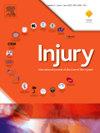Prevalence and predictors of bone mineral density testing after distal radius fracture in menopausal women
IF 2.2
3区 医学
Q3 CRITICAL CARE MEDICINE
Injury-International Journal of the Care of the Injured
Pub Date : 2025-02-15
DOI:10.1016/j.injury.2025.112219
引用次数: 0
Abstract
Background
Osteoporosis screening guidelines recommend bone mineral density (BMD) testing following fragility fractures. Nevertheless, previous studies have demonstrated low rates of osteoporosis screening. Diagnosis and treatment of osteoporosis is essential for prevention of future fractures, however not much is known about the factors associated with receiving BMD testing in this patient population. The purpose of this study was to evaluate the prevalence, timing, and predictors of BMD testing following distal radius fractures (DRF) in menopausal women.
Methods
We queried a national insurance database to identify menopausal women aged 45–64 years with a DRF between years 2013 and 2020. The rate of BMD testing within 1 year of injury was calculated. Multivariable logistic regression analysis was used to evaluate the effect of patient- and injury-related variables on the likelihood of undergoing BMD testing following DRF.
Results
Among 31,728 patients meeting inclusion criteria (mean ± SD age: 57.5 ± 4.3), 3,886 (12.2 %) received a BMD test within 1 year following DRF. The rate of BMD tests decreased with the highest rate of 14.5 % in 2015 and the lowest rate of 10.5 % in 2020. Mean time from DRF to BMD testing was 143 ± 102 days. Patients aged 60–64 had the highest adjusted odds of receiving BMD testing (OR 2.85 [95 % CI: 2.26 to 3.64]). Factors associated with increased likelihood of BMD testing included surgical intervention (OR 1.38 [1.28–1.48]), rheumatoid arthritis (OR 1.22 [1.06–1.40]), osteoarthritis (OR 1.28 [1.19–1.37]), breast cancer (OR 1.35 [1.16–1.56]), and vitamin D deficiency (OR 1.29 [1.17–1.43]). Factors associated with decreased likelihood of testing included tobacco use (OR 0.90 [0.84–0.97]), patients with Medicaid (OR 0.73 [0.61–0.86]) or Medicare (OR 0.76 [0.65–0.88]) insurance, and living in Southern (OR 0.67 [0.62–0.73]) or Western (OR 0.69 [0.62–0.77]) regions of the United States. Obesity, diabetes, renal disease, and early menopause were not associated with BMD testing.
Conclusions
Despite guidelines recommending BMD testing after low-energy fractures, rates of BMD testing were low and decreased among menopausal women with DRF. Mean time to BMD testing was 4.7 months, indicating substantial delays in workup. Known risk factors for osteoporosis did not reliably predict likelihood of BMD testing.
Level of Evidence
Level III, prognostic
背景骨质疏松症筛查指南建议在发生脆性骨折后进行骨矿物质密度(BMD)检测。然而,以往的研究表明骨质疏松症筛查率很低。骨质疏松症的诊断和治疗对于预防未来骨折至关重要,但对于此类患者接受 BMD 检测的相关因素却知之甚少。本研究旨在评估绝经期女性桡骨远端骨折(DRF)后进行 BMD 检测的流行率、时间和预测因素。方法我们查询了一个全国性保险数据库,以确定在 2013 年至 2020 年间发生 DRF 的 45-64 岁绝经期女性。我们计算了受伤后 1 年内进行 BMD 检测的比例。结果在符合纳入标准的 31728 名患者(平均 ± SD 年龄:57.5 ± 4.3)中,有 3886 人(12.2%)在 DRF 后 1 年内接受了 BMD 检测。BMD 检测率有所下降,2015 年最高,为 14.5%,2020 年最低,为 10.5%。从 DRF 到 BMD 检测的平均时间为 143 ± 102 天。60-64 岁患者接受 BMD 检测的调整后几率最高(OR 2.85 [95 % CI:2.26 至 3.64])。与 BMD 检测几率增加相关的因素包括外科干预(OR 1.38 [1.28-1.48])、类风湿性关节炎(OR 1.22 [1.06-1.40])、骨关节炎(OR 1.28 [1.19-1.37])、乳腺癌(OR 1.35 [1.16-1.56])和维生素 D 缺乏(OR 1.29 [1.17-1.43])。与检测可能性降低相关的因素包括吸烟(OR 0.90 [0.84-0.97])、患者有医疗补助(OR 0.73 [0.61-0.86])或医疗保险(OR 0.76 [0.65-0.88])、居住在美国南部(OR 0.67 [0.62-0.73])或西部(OR 0.69 [0.62-0.77])地区。结论尽管指南建议在低能量骨折后进行 BMD 检测,但在患有 DRF 的更年期妇女中,BMD 检测率很低,且有所下降。进行 BMD 检测的平均时间为 4.7 个月,这表明检查工作严重滞后。已知的骨质疏松症风险因素并不能可靠地预测进行 BMD 检测的可能性。
本文章由计算机程序翻译,如有差异,请以英文原文为准。
求助全文
约1分钟内获得全文
求助全文
来源期刊
CiteScore
4.00
自引率
8.00%
发文量
699
审稿时长
96 days
期刊介绍:
Injury was founded in 1969 and is an international journal dealing with all aspects of trauma care and accident surgery. Our primary aim is to facilitate the exchange of ideas, techniques and information among all members of the trauma team.

 求助内容:
求助内容: 应助结果提醒方式:
应助结果提醒方式:


